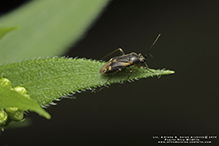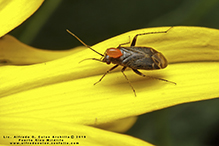plant bugs
(family Miridae)
Overview • Description • Distribution • Taxonomy
Description |
Miridae are soft-bodied, oval or elongated, and small, most less than ½″ (12 mm) in length. They have two large compound eyes and no simple eyes (ocelli). The elongated, tube-like projection containing the mouth parts (beak) has 4 segments. The last part of the leg (tarsus), corresponding to the foot, has 3 segments. On almost all species the forewing has a membranous tip with 2 closed cells, and the thickened part of the forewing (corium) has a hardened, triangular tip (cuneus). |
Distribution |
||
|
Sources |
|
| 10/6/2024 | ||
Taxonomy |
|
Order |
Hemiptera (True bugs, Hoppers, Aphids, and Allies) |
Suborder |
Heteroptera (True Bugs) |
Infraorder |
Cimicomorpha |
Superfamily |
Miroidea |
Subordinate Taxa |
|
Subfamily Bryocorinae Subfamily Cylapinae Subfamily Deraeocorinae Subfamily Isometopinae (jumping tree bugs) Subfamily Mirinae Subfamily Orthotylinae Subfamily Phylinae |
|
Synonyms |
|
Capsidae |
|
Common Names |
|
plant bugs |
|
Glossary
Beak
In plants: A comparatively short and stout, narrow or prolonged tip on a thickened organ, as on some fruits and seeds. In insects: The protruding, tubular mouthpart of a sucking insect.
Corium
The thickened basal portion of the front wing that lies between the clavus and the membrane of insects in the family Hemiptera. Plural: coria.
Cuneus
The triangular, hardened, horn-like tip of the forewing of a plant bug (family Miridae).
Ocellus
Simple eye; an eye with a single lens. Plural: ocelli.
Tarsus
On insects, the last two to five subdivisions of the leg, attached to the tibia; the foot. On spiders, the last segment of the leg. Plural: tarsi.
Visitor Photos |
||
Share your photo of this insect. |
||
This button not working for you? |
||
Alfredo Colon |
||
 |
 |
|
 |
 |
|
 |
 |
|
MinnesotaSeasons.com Photos |
||
|
||
|

Slideshows |
|

Visitor Videos |
||
Share your video of this insect. |
||
This button not working for you? |
||
|
Other Videos |
||
Miridae bug |
About
May 15, 2020 An 8mm long Miridae bug from my garden. Note the two black spots on it thorax by which it simulates to be a much larger insect, discouraging certain pretators. |

Visitor Sightings |
||
Report a sighting of this insect. |
||
This button not working for you? |
||
| Alfredo Colon 6/10/2024 |
Location: Albany, NY |
 |
| Alfredo Colon 8/10/2022 |
Location: Albany, NY |
 |
| Alfredo Colon 8/5/2019 |
Location: Woodbury, Minnesota |
 |
| Alfredo Colon 8/4/2019 |
Location: Woodbury, Minnesota |
 |
MinnesotaSeasons.com Sightings |
||
|

Created: 1/18/2019 Last Updated: © MinnesotaSeasons.com. All rights reserved. |
